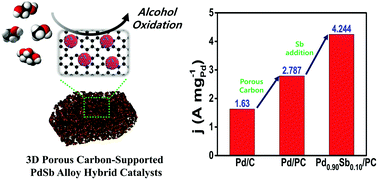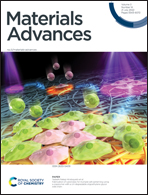Highly active PdSb catalysts on porous carbon for electrochemical oxidation reactions of biomass-derived C1–C3 alcohols†
Abstract
The design of efficient and durable electrocatalysts is a challenge for the development of direct alcohol fuel cells (DAFCs). Herein, highly active and stable PdSb nanoparticle catalysts that are supported on three-dimensional (3D) porous carbon materials (PdxSby/PC) are prepared and investigated for electrooxidation reactions of various C1–C3 alcohols under alkaline conditions. From electrochemical tests, it is found that the optimized Pd0.90Sb0.10/PC catalysts exhibit the highest mass activities for various alcohols such as ethanol, ethylene glycol and glycerol, especially with 2.6 times higher activity than the commercial Pd/C catalysts in the ethanol oxidation reaction (EOR). Furthermore, it shows no significant decay in catalytic activity for over 6 hours of continuous operation. Detailed experimental activity studies and characterization analyses reveal that synergistic effects on the electrocatalytic performance are attributed to the electronic modification of the Pd catalyst by incorporating Sb and the structural feature of 3D porous carbon materials. These findings suggest a novel guidance to the catalyst fields for the direct alcohol-fed fuel cells which require great improvements in terms of catalytic performances and cost.



 Please wait while we load your content...
Please wait while we load your content...